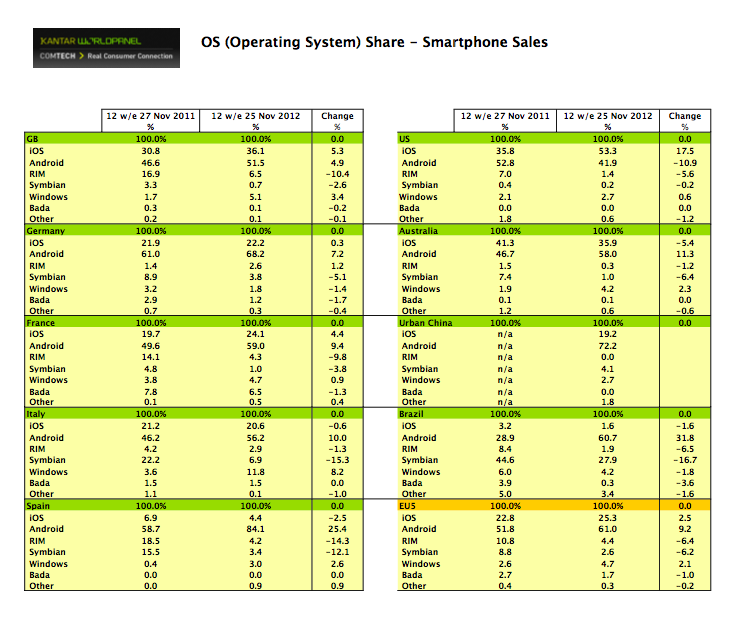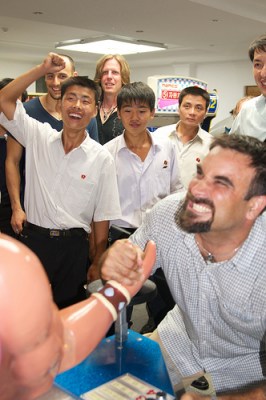Apple’s shares, as you may have seen, have been sliding in the market on the back of strong competition from Android device makers. Today, some new figures on recent smartphone sales will give investors both encouraging and discouraging food for thought on that matter as we dive into the final weekend of sales before Christmas.
According to 12-week sales numbers out from Kantar Worldpanel Comtech — the WPP division that tracks smartphone sales across several key markets on a monthly, rolling basis — Apple is at its highest-ever share of smartphone sales in the U.S., at over 53%. But the question remains whether that is strong enough to offset the fact that Android is increasingly gaining prominence everywhere else. In Europe, Android is at its highest-ever share of sales, at 61%, with Samsung leading the charge; and it is also in the lead in the other key markets that Kantar assesses: Australia, China and Brazil.
Meanwhile, Windows Phone is continuing to gain some momentum. The platform has now surpassed RIM in the U.S. market as the third-most-popular platform, but it’s still miles behind the top two by quite a long way.
The researchers note that in the last 12 weeks ending November 25, Apple’s iPhone range accounted for 53.3% of all smartphone purchases, a rise of more than five percentage points on last month’s 48.1%. As was the case last month, a lot of the momentum is coming from sales of the iPhone 5, Apple’s latest addition to its smartphone line, introduced in September.
Apple’s gain in the U.S. was a mixture of taking share from Android and RIM: Android is at 41.9% but that’s a drop of some 10 percentage points over the same period last year. RIM meanwhile lost nearly 6 percentage points and has now dropped down to fourth, with Windows Phone now in third place with just over 7% of all purchases in the last 12 weeks.
The picture, however, is not as rosy for the iPhone in Europe. Overall, Android is now at its highest-ever percentage of sales, with the various OEMs that make phones based on Google’s platform now accounting for 61% of all smartphone sales in Europe’s top five mobile markets. Apple, in contrast, is at just over 25%.
That charge continues to be led by Samsung. The Korean handset maker’s Galaxy line of devices accounted for 44% of all smartphone sales across the European big-five of the UK, Germany, France, Italy and Spain — meaning that, even comparing brand-to-brand, it’s doing better than Apple. Given that Apple has not really made any forays into targeting the cheaper end of the smartphone market — notwithstanding the fact that it continues to sell older models of the iPhone — as economic pressures continue to weigh on consumers in Europe, this trend is likely to continue.
And developing markets are likely to follow suit, too. In the two that Kantar tracks — Brazil and China — Android phones respectively accounted for 60.7% and 72.2% of all sales in the last 12 weeks.
Windows Phone and its main licensee Nokia, meanwhile, continue to see gains — albeit still on a modest scale that is not able to break the hegemony of Apple and Android.
In the U.S., as we noted above, it’s now passed RIM as the third-most-popular platform for smartphone buyers. In the UK, it’s still at number-four after Android, Apple, and RIM. But if RIM continues to drop fast — its sales fell by more than 10 percentage points over the last year in the UK — Windows Phone will overtake RIM by next month in the UK.
But at what cost to margin, is perhaps one question we should ask. Kantar notes that part Nokia’s success has come in the form of “keenly priced” devices being sold on prepay contracts:
“Nokia is managing to claw back some of its share in Great Britain through keenly priced Lumia 800 and 610 prepay deals. The next period will prove crucial in revealing initial consumer reactions to the Nokia 920 and HTC Windows 8X devices,” writes analyst Dominic Sunnebo.
What Nokia may need to work on next is getting younger users (another key, price-sensitive segment) more interested in its brand.
Kantar notes that over the past six months, only 28% of Nokia Lumia 800 sales came from under 35’s, but that group collectively accounted for 42% of all smartphone sales. Sunnebo speculates that this might see Nokia applying even more competitive pricing to some of its newer high-end devices, such as the Lumia 920 that works on the EE LTE network.

Image Flickr
